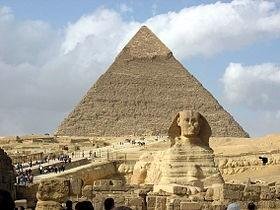The Great Sphinx and the pyramids of Giza

For the British history magazine, see Ancient Egypt (magazine).
"Ancient Egyptian" redirects here. For the language, see Egyptian language.
The Great Sphinx and the pyramids of Giza are among the most recognizable symbols of the civilization of ancient Egypt.
Ancient Egypt was a civilization of ancient Northeastern Africa, concentrated along the lower reaches of the Nile River in the place that is now the country Egypt. It is one of six historic civilizations to arise independently. Egyptian civilization followed prehistoric Egypt and coalesced around 3150 BC (according to conventional Egyptian chronology)[1] with the political unification of Upper and Lower Egypt under the first pharaoh, Narmer (commonly referred to as Menes).[2] The history of ancient Egypt occurred as a series of stable kingdoms, separated by periods of relative instability known as Intermediate Periods: the Old Kingdom of the Early Bronze Age, the Middle Kingdom of the Middle Bronze Age and the New Kingdom of the Late Bronze Age.
Bronze Age
This box: view talk edit
↑ Chalcolithic
Near East (c. 3300–1200 BC)
Anatolia, Caucasus, Elam, Egypt, Levant, Mesopotamia, Sistan, Canaan
Late Bronze Age collapse
South Asia (c. 3000–1200 BC)
Ochre Coloured Pottery
Cemetery H
Europe (c. 3200–600 BC)
Aegean, Caucasus, Catacomb culture, Minoan, Srubna culture, Beaker culture, Unetice culture, Tumulus culture, Urnfield culture, Hallstatt culture, Apennine culture, Canegrate culture, Golasecca culture,
Atlantic Bronze Age, Bronze Age Britain, Nordic Bronze Age
China (c. 2000–700 BC)
Erlitou, Erligang
arsenical bronze
writing, literature
sword, chariot
↓Iron Age
Egypt reached the pinnacle of its power in the New Kingdom, during the Ramesside period, where it rivalled the Hittite Empire, Assyrian Empire and Mitanni Empire, after which it entered a period of slow decline. Egypt was invaded or conquered by a succession of foreign powers, such as the Canaanites/Hyksos, Libyans, the Nubians, the Assyrians, Babylonians, the Achaemenid Persians, and the Macedonians in the Third Intermediate Period and the Late Period of Egypt. In the aftermath of Alexander the Great's death, one of his generals, Ptolemy Soter, established himself as the new ruler of Egypt. This Greek Ptolemaic Kingdom ruled Egypt until 30 BC, when, under Cleopatra, it fell to the Roman Empire and became a Roman province.[3]
The success of ancient Egyptian civilization came partly from its ability to adapt to the conditions of the Nile River valley for agriculture. The predictable flooding and controlled irrigation of the fertile valley produced surplus crops, which supported a more dense population, and social development and culture. With resources to spare, the administration sponsored mineral exploitation of the valley and surrounding desert regions, the early development of an independent writing system, the organization of collective construction and agricultural projects, trade with surrounding regions, and a military intended to defeat foreign enemies and assert Egyptian dominance. Motivating and organizing these activities was a bureaucracy of elite scribes, religious leaders, and administrators under the control of a pharaoh, who ensured the cooperation and unity of the Egyptian people in the context of an elaborate system of religious beliefs.[4][5]
The many achievements of the ancient Egyptians include the quarrying, surveying and construction techniques that supported the building of monumental pyramids, temples, and obelisks; a system of mathematics, a practical and effective system of medicine, irrigation systems and agricultural production techniques, the first known planked boats,[6] Egyptian faience and glass technology, new forms of literature, and the earliest known peace treaty, made with the Hittites.[7] Egypt left a lasting legacy. Its art and architecture were widely copied, and its antiquities carried off to far corners of the world. Its monumental ruins have inspired the imaginations of travelers and writers for centuries. A new-found respect for antiquities and excavations in the early modern period by Europeans and Egyptians led to the scientific investigation of Egyptian civilization and a greater appreciation of its cultural legacy.[8]